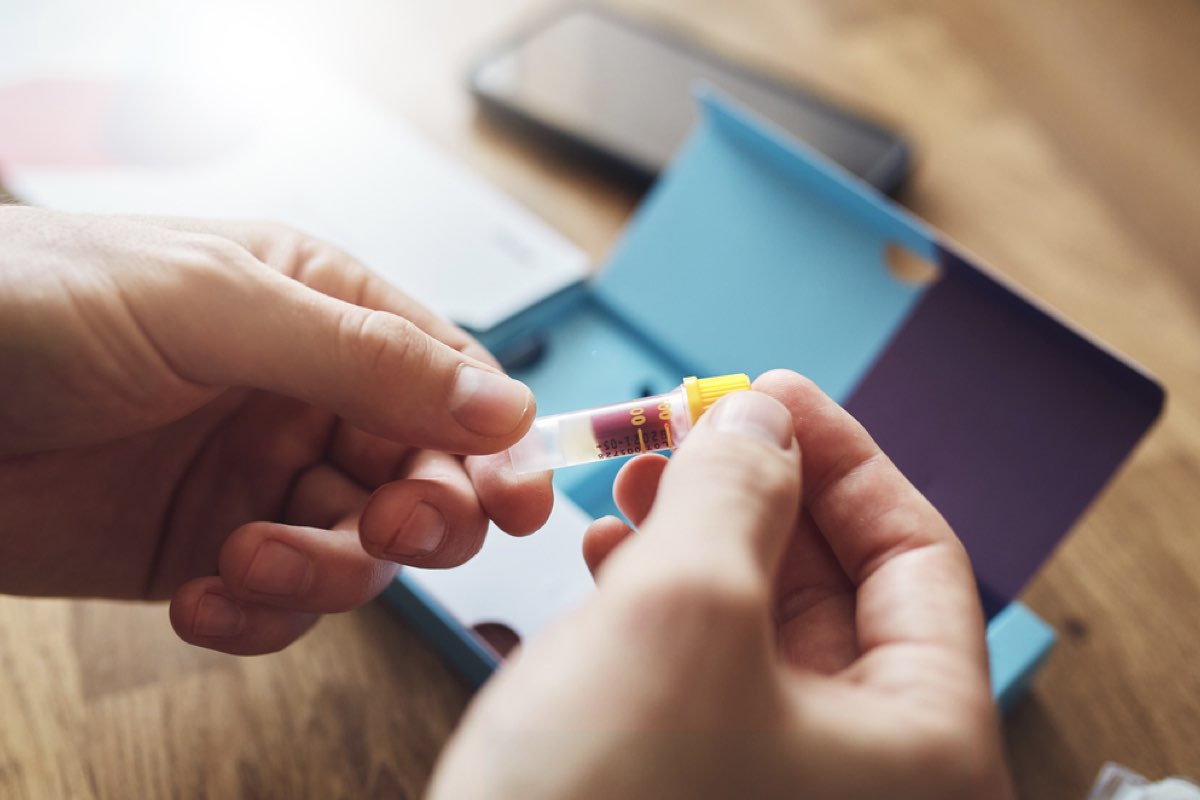Do you want to make sure your body is ready for pregnancy, or learn if symptoms such as irregular periods or acne might be caused by PCOS? Perhaps you’re a new mum and want to analyse your vitamin D and iron levels. The good news is, there’s a Thriva test that can help. Understanding what’s really going on inside your body has never been easier with a smart finger-prick blood test you take at home. We spoke to three women at different stages of life about what they learnt from their at home women’s health Thriva test and why they’ll be recommending it to all their friends…

Receive 20% off all women’s health packages with code ‘DOSE20’. Buy now
Emily, PCOS Women’s Health Thriva Test
Which Thriva test did you take?
I took the PCOS Thriva Test to learn if I have the condition. As one of the main features of PCOS, the home blood test checks whether you have high testosterone levels. If the results show that you do, and you have irregular periods, you can usually make a PCOS diagnosis. Or you can have an ultrasound to be sure. Other symptoms of PCOS include difficulty getting pregnant, excess body hair and weight gain. This Thriva test also tracks your luteinising hormone, vitamin D levels, thyroid function, cholesterol and more.
The test can also be done by people who’ve already been diagnosed with PCOS. It can help them to manage their symptoms, monitor their hormone levels and get advice on how to lower their risk of longer-term issues associated with the condition.
How much does the test cost: £92.00
Why did you take the test and what were your expectations?
I’ve always had very heavy periods, dysmenorrhea that stops me from doing day-to-day activities and lower back pain, which worsens when I bleed. I’ve visited my GP regularly over the years and take mefenamic acid during my cycle to ease the pain but haven’t had much luck. So, taking the PCOS Thriva test was a chance for me to learn more about what’s causing my symptoms and how best to treat them as soon as possible.
What were your results?
Finding out of range raised testosterone levels, the doctor concluded that my results suggest PCOS. However, my periods are regular and she actually suspects that endometriosis fits my symptoms more. The doctor asks me to be referred to a gynaecologist by my GP who can explore further.
Conditions like PCOS and endometriosis can worsen over time and can end up affecting your fertility if untreated. On average, it takes 7.5 years for endometriosis to be diagnosed, even though it is the second most common gynaecological condition and affects one in 10 women.
Endometriosis doubles the risk of infertility in under 30’s, so, if you think this condition might be a possibility for you too, insist your GP refers you to a gynaecologist and begin managing your symptoms. For years I’d been putting off seeing a gynaecologist as I was scared of the outcome.
Where to go from here?
Thriva has helped reassure me that you shouldn’t ignore out of the ordinary symptoms and to look after my body better.
Taylor, Fertility Women’s Health Thriva Test
Which Thriva test did you take?
I took the Fertility Insights Thriva test, which looks at a range of hormones and nutrients that are important for fertility. It can also indicate if you have a condition that might affect your fertility, like a thyroid condition. It won’t tell you how likely you are to get pregnant or if you’re infertile.
Combined with a GP-report and advice on how to improve your results, you also receive the support you need to take fertility into your own hands.
How much does the test cost: £99.00
Why did you take the test and what were your expectations?
Due to my delayed wedding (which has moved from June 2021 to October 2022) I’ve now moved back trying to have a baby in my “life schedule”. It’s now likely I’ll wait until after the wedding in 2022 to start trying. But I’ve always been intrigued about fertility tests, so I thought now was a great time to try it out to see how things are going in preparation for next year.
My expectations were to find out ways in which I could improve and help my hormones in preparation for when I’m ready to take the next step. I was also hoping it would flag anything I might need to investigate further. I’ve never had my hormones looked into so it was all new to me.
What were the results of your Thriva test?
On the whole all my results were normal or optimal (within the guided range) which was great. There were two slight concerns; my vitamin D was in range but could do with a boost and my FSH levels were higher than they should be. FSH = Follicle-stimulating hormone (FSH) helps your ovaries to function normally and plays a key role in egg production and ovulation. If your FSH levels are imbalanced you might have trouble getting pregnant. Or high FSH levels can be a sign that you’re menopausal.
FSH note from Thriva GP
“Your FSH levels are raised. Causes of a high FSH include, peri/menopause, a thyroid disorder, an autoimmune disease, cancer treatment, or in rare cases, ovarian cancer. I would therefore advise seeing your GP if you have any symptoms including: bloating, feeling more full than usual after eating, change in appetite, pressure in your pelvis or back, change in your bowel habits, feeling the need to pass urine more frequently or increased tiredness”.
Vitamin D note from Thriva GP
“Your levels are in range but slightly below optimal. NHS England suggest that everyone in the UK
would benefit from a vitamin D supplement daily. If you have renal disease, hyperparathyroidism, sarcoidosis or are under the care of a renal, endocrinologist or cancer specialist, please speak to your doctor before starting a supplement.”
Where to go from here?
I’m going to up my vitamin D intake – an easy, quick win that I can start implementing now to help improve my chances of fertility (and general well-being). For the FSH, I am scheduling an appointment with my doctor to look into it in more detail, just in case there is anything to be concerned about. From a quick conversation with my GP it could be an anomaly, but worth looking into!

Hettie, Post-Birth Women’s Health Check
Which Thriva test did you take?
I took the Post-Birth Thriva Test to get insights about my health after pregnancy and birth. This Thriva test can tell you if you have optimal levels of some of the nutrients that help you recover from birth, support energy levels and promote better sleep. Three things I could really use more of right now with two under two! I gave birth 7 months ago, so I am more intrigued to see how breastfeeding is affecting my nutrient levels.
How much does the test cost: £95.00
Why did you take the test and what were your expectations?
I am conscious that as I am breastfeeding, my requirements for certain nutrients have increased. It’s been a rocky road with sleep, as my youngest wakes regularly in the night causing me to crave coffee and sugar the next morning to boost my energy. Because of this extra demand on my body (my baby is quite literally leeching the calcium from my bones!) I know I am at risk of developing a nutritional deficiency. While optimum sleep isn’t something I can exactly control right now, I wanted to see if I am deficient in any key nutrients.
What were the results of your Thriva test?
It’s always reassuring to see the words “these results are all normal”. My lifestyle information indicates that I am currently living in a way that is consistent with optimum health. But there is room for improvement.
My vitamin B9 (Folate) levels are at the bottom end of the normal range. Folate, also called vitamin B9 or folic acid, is needed for a healthy liver, skin, hair, and eyes. It plays a key role in forming red blood cells — which carry oxygen around your body. I took a supplement during pregnancy for my folate levels, as it is essential for the development of a baby’s brain and spinal cord. My Thriva test indicates that my result is reassuring and I should continue with my balanced diet and inclusion of folate rich foods such as leafy, green vegetables. Apparently 47% of users with a similar Folate level moved towards optimal within 3 months.
My vitamin B12 levels are within the normal range. Together with folate and iron, B12 plays a key role in forming red blood cells. It’s also important for a healthy nervous system and plays a role in protecting against heart disease. I am to carry on with my balanced diet and inclusion of vitamin B12 rich foods such as fish, eggs and beef. When making vegan choices, I should take a nutritional supplement.
As for Ferratin levels, my results are optimal, which is a grade above normal. Ferritin is a protein that stores iron so my results indicate that I do not have an iron deficiency. If your diet is low in iron, try to include more iron-rich foods like dark green, leafy vegetables and nuts.
My vitamin D levels are only sufficient. This is of particular interest to me as breastfeeding woman are at higher risk of vitamin D deficiency than non-breastfeeding women. Vitamin D helps your body absorb calcium. If you don’t get enough vitamin D you might feel tired, get sick often, have weak bones and muscle pain, and feel anxious or depressed. To up my levels, my Thriva test suggests more exposure to sunlight. In winter months, a nutritional supplement is advised but I am going to take one regardless so I get in the optimum range.
Where to go from here?
I will be upping my sunlight exposure, taking a regular vitamin D supplement as well as packing in the leafy green veg into my diet! These are things I was already aware of but my Thriva test has given me the motivation to start taking better care of my health.
This is a partnership feature with Thriva
Get your weekly DOSE fix here: SIGN UP FOR OUR NEWSLETTER

















